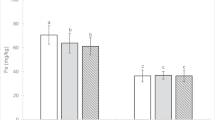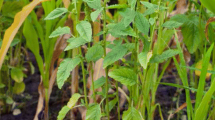Abstract
Multivariate analysis of data obtained from 184 cereal and stubble fields in low-input agricultural systems located in western Hungary was undertaken in order to asses environmental factors affecting weed species composition. For each variable, the gross and net effect on weed species composition was calculated. All variables considered in this study had a significant effect on weed species composition and explained 26.99% of the total variation. Most variation in species composition was explained by the aspect (cereal vs. stubble), followed by soil pH, mean annual precipitation, soil texture, mean annual temperature, and altitude. Separating the cereals and stubbles soil pH became the most important factor. Our results suggest that during the long vegetation period, cereal weed communities dominated by winter annuals are replaced by stubble-field weed communities dominated by summer annuals. This seasonal change may also have the same important effect on weed species composition as crop types.
Similar content being viewed by others
References
Cimalová S., Lososová Z., Arable weed vegetation of the northeastern part of the Czech Republic: effects of environmental factors on species composition, Plant Ecol., 2009, 203, 45–57
Fried G., Norton L.R., Reboud X., Environmental and management factors determining weed species composition and diversity in France, Agric. Ecosyst. Environ., 2008, 128, 68–76
Šilc U., Vrbničanin S., BožiĆ D., Čarni A., Stevanović D., Phytosociological alliances in the vegetation of arable fields in the northwestern Balkan Peninsula, Phytocoenologia, 2008, 38, 241–254
Ujvárosi M., Gyomirtás (Weed control), Mezőgazdasági Kiadó, Budapest, 1973, (in Hungarian)
Holzner W., Weed species and weed communities, Vegetatio, 1978, 38, 13–20
Schneider C., Sukopp U., Sukopp H., Biologischökologische Grundlagen des Schutzes gefährdeter Segetalpflanzen, Schriftenreihe f. Vegetationskunde 26, Bonn-Bad Godersberg, 1994, (in German)
Litterski B., Jörns S., Der Einfluss extensiven Anbaus von Winterroggen auf die Segetalflora und vegetation — eine Untersuchung in Nordosdeutschland, Z. Pflanzenk. Pflanzen., 2004, 19, 65–72, (in German)
Šilc U., Čarni A., Changes in weed vegetation on extensively managed fields of central Slovenia between 1939 and 2002, Biologia, 2005, 60, 409–416
Pinke G., Pál R., Phytosociological and conservational study of the arable weed communities in western Hungary, Plant Biosyst., 2008, 142, 491–508
Pinke G., Pál R., Floristic composition and conservation value of the stubble-field weed community, dominated by Stachys annua in western Hungary, Biologia, 2009, 64, 279–291
Pinke G., Pál R., Botta-Dukát Z., Chytrý M., Weed vegetation and its conservation value in three management systems of Hungarian winter cereals on base-rich soils, Weed Res., 2009, 49, 544–551
Marosi S., Somogyi S., Magyarország kistájainak katasztere (Regional cadastres in Hungary). MTA Földrajz Kut Int, Budapest, 1990, (in Hungarian)
Dierschke H., Pflanzensoziologie: Grundlagen und Methoden. Ulmer, Stuttgart, 1994, (in German)
Hofmeister H., Garve E., Lebensraum Acker. Blackwell, Berlin, 1998, (in German)
Legendre P., Gallagher E., Ecologically meaningful transformations for ordination of species data, Oecologia, 2001, 129, 271–280
Lososová Z., Chytrý M., Cimalová Š., Kropáč Z., Otýpková Z., Pyšek P., et al., Weed vegetation of arable land in Central Europe: Gradients of diversity and species composition, J. Veg. Sci., 2004, 15, 415–422
R Development Core Team, R: A language and environment for statistical computing. R Foundation for Statistical Computing, Vienna, Austria, ISBN 3-900051-07-0, URL http://www.R-project.org., 2009
Šilc U., Vrbničanin S., Božić D., Čarni A., Stevanović D., Weed vegetation in the north-western Balkans: diversity and species composition, Weed Res., 2009, 49, 602–612
Tarmi S., Helenius J., Hyvönen T., Importance of edaphic, spatial and management factors for plant communities of field boundaries, Agric. Ecosyst. Environ., 2009, 131, 201–206
Holzner W., Hayashi I., Glauninger J., Reproductive strategy of annual agrestals, In: Holzner W., Numata N., (Eds.), Biology an ecology of weeds, Junk, Hague, 1982
Ubrizsy G., Vizsgálatok őszi búzavetés agrofitocönózisában (Surveys on the agrophytocoenoses of winter wheat stands), Növénytermelés, 1954, 3, 281–299, (in Hungarian)
Pinke G., Pál R., Gyomnövényeink eredete, termőhelye és védelme (The origin, habitat and conservation of our arable weeds), Alexandra Kiadó, Pécs, 2005, (in Hungarian)
Kropáč Z., Hadač E., Hejný S., Some remarks on the synecological and syntaxonomic problems of weed plant communities, Preslia, 1971, 43, 139–153
Lososová Z., Chytrý M., Cimalová Š., Otýpková Z., Pyšek P., Tichý L., Classification of weed vegetation of arable land in the Czech Republic and Slovakia, Folia Geobot., 2006, 41, 259–273
Hüppe J., Hofmeister H., Syntaxonomische Fassung und Übersicht über die Ackerunkrautgesellschaften der Bundesrepublik Deutschland, Ber. Reinh. Tüxen-Ges., 1990, 2, 61–81, (in German)
Mucina L., Stellarietea mediae, In: Mucina L., Grabherr G., Elmmauer T., (Eds.), Pflanzengesellschaften Österreichs. Teil I. Anthropogene Vegetation, Gustav Fischer, Jena, 1993, (in German)
Kropáč Z., Segetal vegetation in the Czech Republic: synthesis and syntaxonomical revision, Preslia, 2006, 78, 123–209
Oberdorfer E., Süddeutsche Pflanzengesellschaften, Teil III, Gustav Fischer, Jena, 1983, (in German)
Glemnitz M., Radics L., Hoffmann J., Czimber G., Weed species richness and species composition of different arable field types — A comparative analysis along a climate gradient from south to north Europe, J. Plant Dis. Protect., 2006, 20, 577–586
Schubert R., Mahn E., Übersicht über die Ackerunkrautgesellschaften Mitteldeutschlands, Fedd. Repert., 1968, 80, 133–304, (in German)
Meisel K., Veränderung der Ackerunkraut- und Grünlandvegetation in landwirtschaftlichen Intensivgebieten, Schrr. Dt. Rat. Landespfl., 1983, 42, 168–173, (in German)
Andreasen C., Skovgaard I.M., Crop and soil factors of importance for the distribution of plant species on arable fields in Denmark, Agric. Ecosyst. Environ., 2009, 133, 61–67
Pinke G., Letzte Vorkommen von Caucalion-Arten im Nordwesten Ungarns. Z. Pflanzenk. Pflanzen., 2004, 19, 73–82, (in German)
Pinke G., Pál R., Király G., Szendrődi V., Mesterházy A., The occurrence and habitat conditions of Anthoxanthum puelii Lecoq & Lamotte and other Atlantic-Mediterranean weed species in Hungary, J. Plant Dis. Protect., 2006, 20, 587–596
Ries C., Überblick über die Ackerunkrautvegetation Österreichs und ihre Entwicklung in neurer Zeit, Diss., Bot., 1992, 187, 1–188, (in German)
Ujvárosi M., Gyomnövények (Weeds), Mezőgazdasági Kiadó, Budapest, 1973, (in Hungarian)
Author information
Authors and Affiliations
Corresponding author
About this article
Cite this article
Pinke, G., Pál, R. & Botta-Dukát, Z. Effects of environmental factors on weed species composition of cereal and stubble fields in western Hungary. cent.eur.j.biol. 5, 283–292 (2010). https://doi.org/10.2478/s11535-009-0079-0
Received:
Accepted:
Published:
Issue Date:
DOI: https://doi.org/10.2478/s11535-009-0079-0




